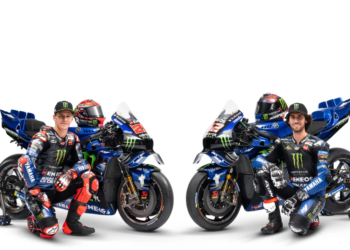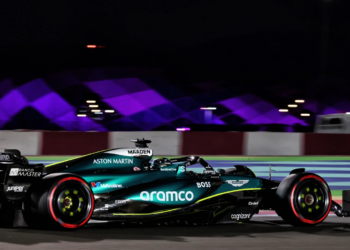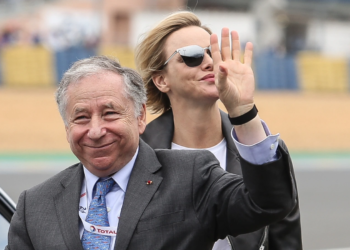After the unforgettable Spanish Grand Prix a couple of weeks ago, the Formula 1 fraternity arrived in the iconic principality of Monaco transfixed as to what the next chapter of the 2016 season had in store.
Throughout the three practice sessions no true answers were found as to which team or driver had the overall upper hand, and after a frenetic qualifying hour Daniel Ricciardo rose out on top and secured his maiden pole position in F1.
Then the rain fell!
And as ever at Monte-Carlo when precipitation is involved, utter mayhem reigns down!
After starting from behind the safety car and including numerous spills and thrills, Grand Prix Times’ Andy Young takes a look at five talking points from a crazy Monaco Grand Prix.
1. Hamilton perfectly balances lady luck and pure skill to secure victory
After yet another stressful qualifying hour and with mechanical gremlins momentarily plaguing his efforts, Lewis Hamilton entered the race with a point to prove in more ways than one.
Up until the start of the Monaco Grand Prix, Hamilton had only led one racing lap in 2016, such has been team-mate Nico Rosberg’s dominance and the recurring poor luck for the Briton.
Once the race finally got underway after starting from behind the safety car, it became apparent that lady luck seemed to be sitting on Hamilton’s side of the garage for once.
At first it seemed Ricciardo had the race in the bag after he opened up a staggering 13 second lead by Lap 16.
However, it’s fair to say this significant lead was largely due to Rosberg’s abysmal pace in the Mercedes, with the championship leader struggling greatly with brake issues.
For several laps the German was clearly holding up his team-mate, forcing the Mercedes pit wall to deploy team orders and instruct Rosberg to allow Hamilton through as a long train of cars were beginning to form behind the Briton.
This enabled Hamilton to gradually erode Ricciardo’s lead down to just over 10 seconds before the Red Bull racer’s first pit-stop for the intermediate tyre on Lap 23.
Ricciardo rejoined nine seconds behind new race leader Hamilton, who now had the bit firmly between his teeth as his first strategic conundrum presented itself to him – stay out on slowly degrading full wets and miraculously make the move straight to slick tyres or immediately react to Ricciardo and opt for the intermediates.
Hamilton and Mercedes boldly elected to stay out and wait for the track to dry, enabling them to instantly switch to the dry ultra soft tyres on Lap 31, with Ricciardo now less than one second behind him.
Now came the biggest slice of luck of the entire race weekend for Hamilton, as when Ricciardo pitted for dry tyres on Lap 32 with well over 25 seconds between himself and the Mercedes racer, Red Bull were caught with their trousers down as Ricciardo’s super-soft tyres were not ready for him.
This left Ricciardo sat in his pit box for a painstaking amount of time as his Red Bull mechanics ran to and fro to get his tyres ready in scenes reminiscent of Eddie Irvine at the Nurburgring in 1999 or even Esteban Tuero at Buenos Aires in 1998!
This enabled Hamilton to retake the lead of the race by just over two seconds, however Ricciardo soon lowered that gap significantly to well under a second.
The latter stages of the race for Hamilton featured both one more stroke of luck and also one major feat of supremacy.
On one side of the spectrum Hamilton was lucky to both avoid losing the lead at Turn 10 on Lap 38 after cutting the chicane, and then harshly blocking Ricciardo on the exit.
With Ricciardo considerably flustered and the race stewards briefly investigating his actions, nothing came of it and Hamilton’s lead remained intact.
But most surprising of all was Hamilton’s ability to maintain the life of his ultra soft tyres for a whopping 47 laps!
Some may say that luck wasn’t a factor during Hamilton’s race. But the truth of it is each time a driver completes 78 laps of the Monte-Carlo street circuit without clouting the barriers, luck almost always plays a key role.
It was a masterful drive from the Briton, yes, but there’s no denying that had Red Bull been on the ball during Ricciardo’s pit-stop, the Australian would’ve maintained his lead and quite possibly kept it and secured a victory of his own.
2. Heartbreak for Ricciardo as Red Bull costs him victory once again
After Max Verstappen’s unbelievable drive to victory at the Spanish Grand Prix, there were two drivers who were left bitterly disappointed as the post-race test began: Ricciardo and Daniil Kvyat.
Kvyat’s bitterness speaks for itself, as Verstappen’s victory came at the first race weekend after the Dutchman replaced Kvyat at Red Bull.
But Ricciardo’s frustrations were a completely different kettle of fish.
After assuming the lead after Rosberg and Hamilton’s collision, Ricciardo remained on what eventually became a slower three-stop strategy whilst Red Bull switched team-mate Verstappen to a two-stop strategy and managed to storm to victory.
Meanwhile Ricciardo found himself behind Sebastian Vettel in the Ferrari, and then struck with a puncture in scenes reminiscent to that of China earlier in the season.
But at Monaco Ricciardo was eager to bounce back with an upgraded 8Renault engine in his Red Bull, and the Australian ace did just that by storming to his maiden pole position.
After the safety car pulled in and the race really started in treacherously wet weather conditions Ricciardo opened up a considerable lead, even when Hamilton was given clear air after passing Rosberg.
Although he lost the lead when he pitted and initially failed to regain it as Hamilton extended his first stint, Ricciardo soon lead once again after the Mercedes racer pitted and soon had an even stronger gap at the front.
But then his chances of victory were ruined and once again by his own team, as they failed to have his super-soft tyres ready for him for his second and final pit-stop.
Although Ricciardo managed to finish a comfortable second behind race winner Hamilton, there’s no denying that the trust between the Australian and his team has reached an all-time low after this weekend.
Already Ricciardo has stated that he’s “not sure where to go” after the pit-stop blunder at Monaco, and it’s quite clear that the loss of victory at Monaco has hit him harder than that at Barcelona.
With Verstappen entering Red Bull in a whirlwind of popularity and immediate success and team support, is it possible that Ricciardo could look elsewhere should these blunders no immediately stop.
Red Bull are clearly on the rise once again, and with the improved Renault engine a victory in the future is surely a necessity for both Ricciardo and Red Bull if their relationship is going to both continue and heal over after two trying weekends for both involved.
3. Super strategy from Perez and Force India
Probably the most surprising result of the Monaco Grand Prix came courtesy of Sergio Perez and Force India, after the Silverstone-based outfit mastered a terrific strategy by placing the Mexican on the soft tyre compound for his final stint.
Just like every other driver except for Hamilton and Pascal Wehrlein, Perez’s first pit-stop saw him switch from the full wet tyres to the intermediates on Lap 22.
The Mexican rejoined proceedings in fourth position, leapfrogging ahead of Carlos Sainz, Nico Hulkenberg and Vettel in the process.
However, the true stroke of genius came during their second stop as Perez became only the second driver to opt for dry tyres after Marcus Ericsson.
Although Perez initially rejoined the action in 11th position, the Mexican had the soft tyre compound bolted to his Force India, the hardest of the three dry compounds available throughout the weekend.
Soon Perez found himself rising back through the order as the rest of the field quickly followed suit for dry tyres, and not before long the Mexican racer found himself sat in a remarkable third position on Lap 33.
But the height of Perez and Force India’s efforts didn’t stop there, as Perez not only held his third position ahead of four-time world champion and Ferrari racer Vettel, but also set numerous fastest laps in the process on his way to his sixth podium finish in F1.
So far this season Perez has well and truly asserted his authority within the Force India camp, thoroughly out-performing team-mate Hulkenberg on numerous occasions.
Throughout the last three races alone Perez has comfortably finished within the top ten, whereas Hulkenberg has retired from two races before bouncing back to finish sixth at Monaco.
Ironically Hulkenberg’s resurgence during the final lap of the Monaco Grand Prix may well have been missed by his own team, as whilst he was overtaking championship leader Rosberg for sixth, team-mate Perez was crossing the line to secure only the team’s fourth podium.
For Perez such results are crucial, with rumours circulating the paddock immediately after the Monaco Grand Prix that Force India would offer Perez a contract extension to remain with the team for 2017.
4. Blue on blue at Sauber after team order blunder
So far this season Sauber has endured enough woes to last several seasons, with financial struggles greatly affecting proceedings off the track whilst a considerable lack of points has done likewise on the track.
But during the Monaco Grand Prix, Sauber’s season took an embarrassing dive as the team tried to employ team orders but instead saw their two drivers collide with each other and both enter retirement.
While battling for 15th position during the closing stages of the Monaco Grand Prix, Felipe Nasr’s race engineer instructed the Brazilian to give his position to team-mate Ericsson.
Immediately Nasr questioned the team’s orders, whilst Ericsson was left under the impression that maybe his team-mate was suffering from radio issues and therefore wasn’t receiving the order to let him through.
On Lap 50 Ericsson tried a manoeuvre on his team-mate at Rascasse, resulting in an embarrassing collision with his team-mate.
Although both drivers managed to continue circulating and limp back to the pits, both soon retired due to damage sustained in the incident.
Whilst team boss Monisha Kaltenborn branded her driver’s actions as “unacceptable”, one must view the situation from outside the box.
Admittedly Ericsson was on a different strategy to that of his team-mate. However, even if Ericsson had successfully overtaken Nasr for 15th, the duo were still miles away from even potentially scoring a world championship point.
So instead of make sure both cars safely reached the chequered flag, and with the rate of attrition normally experienced at Monaco possibly even scoring point just for finishing, the team created an unnecessary situation for itself.
Both Nasr and Ericsson are pay drivers, and are renowned for it – and therefore will perhaps be more unwilling to obey team orders than the likes of Rosberg, Ricciardo and Button who were paid to drive by their team.
It’s like instructing a GP2 or GP3 driver to yield for his team-mate. Chances are he or she will simply ignore you as they are paying for their right to be in the cockpit and will want to finish ahead of anyone else in that same category.
However, from the team’s perspective they simply wanted their faster driver to be in front and with a chance of overtaking Romain Grosjean in the Haas who at the time was only two second up the road.
Regardless of whether Sauber’s intentions were correct or not, the team still sist tied on no points with Manor, and given its increasingly uncertain financial status a point could prove lifesaving in the next few races.
5. Kvyat’s downward spiral continues at Monaco and into Canada
After finishing on the podium at the Chinese Grand Prix earlier in the season, you would’ve been forgiven for foreseeing Kvyat’s sudden sharp decline down the pecking order following his Russian Grand Prix antics.
Since that sensational podium finish and quite aggressive manoeuvre on Vettel into Turn 1, the Russian racer has been replaced by Verstappen at Red Bull and demoted back to Toro Rosso, only to watch the Dutchman storm to immediate victory at Barcelona.
Although Kvyat managed to secure the fastest lap of the race at the Spanish Grand Prix, his overall brand has continued to lose credibility after a Monaco Grand Prix to forget.
The former GP3 champion initially started the race from a relatively competitive eighth on the grid, but after only two laps behind the safety car Kvyat was called into the pits with a mechanical issue seemingly plaguing his car.
Kvyat was heard exclaiming over the team radio that he was stuck in a constant speed, and after a lengthy pit-stop and another run through the pits, he found himself a lap behind the rest of the field without a single green flag lap completed.
Whilst striving to make up for his abysmal start to the race, Kvyat’s afternoon took a final and depressing plunge on Lap 20 when he lunged up the inside of Kevin Magnussen at Rascasse.
The duo had made minor contact earlier in the lap through the Swimming Pool section, however Kvyat’s frustration clearly got the better of him and lead to an embarrassing end to his day.
However, Kvyat’s woes didn’t stop there. Although the Russian was forced into retirement along with Magnussen several laps later, the race stewards investigated the collision and eventually struck Kvyat with a three-place grid penalty for the Canadian Grand Prix as well as two penalty points.
After a stressful and depressing month for Kvyat, there’s no denying the Russian desperately requires a quiet and calm race weekend at Montreal.
He was replaced at Red Bull for a combination of poor internal relations with the team, something he so desperately needs to avoid at Toro Rosso if he wishes to rise back to the heights of his Red Bull days.






